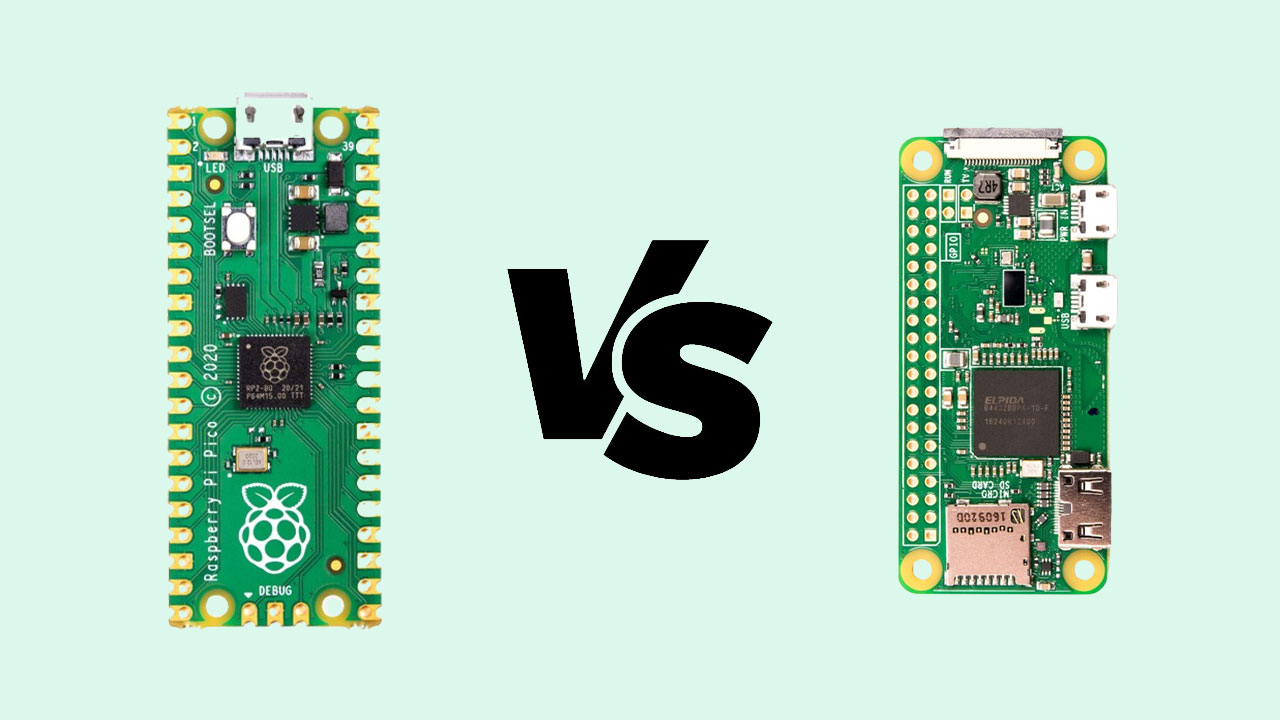No products in the cart.

- by Raspberry Pi BD
- 0 Comments
- Comparison
- 1051 Views
Raspberry Pi offers a range of products designed to cater to various needs, from learning programming to building sophisticated projects. Two popular models are the Raspberry Pi Pico and the Raspberry Pi Zero. While both are compact and affordable, they serve different purposes and come with distinct features. In this blog post, we’ll compare the Raspberry Pi Pico and Raspberry Pi Zero in detail, highlighting their specifications, use cases, and differences.
Overview
Raspberry Pi Pico: Introduced in January 2021, the Raspberry Pi Pico is the first microcontroller from Raspberry Pi. It is built on the RP2040 microcontroller chip designed by Raspberry Pi and is intended for embedded systems, IoT applications, and as a learning platform for microcontroller programming.
Raspberry Pi Zero: The Raspberry Pi Zero was first released in November 2015 as a smaller and cheaper version of the original Raspberry Pi. It is a full-fledged computer with GPIO pins, HDMI output, and USB ports, making it suitable for projects that require more processing power and peripheral connectivity.
Key Specifications
| Feature | Raspberry Pi Pico | Raspberry Pi Zero |
|---|---|---|
| Processor | Dual-core ARM Cortex-M0+ @ 133 MHz | Single-core ARM11 @ 1 GHz |
| RAM | 264KB SRAM | 512MB LPDDR2 |
| Storage | 2MB Flash (external storage via QSPI) | microSD slot |
| GPIO Pins | 26 | 40 |
| USB | 1x Micro-USB (Device) | 1x Micro-USB (OTG), 1x Mini-HDMI |
| Wireless Connectivity | None | Optional (Wi-Fi on Zero W, Zero WH) |
| Power Consumption | Low (Designed for low-power applications) | Moderate |
| Dimensions | 51mm x 21mm | 65mm x 30mm |
| Price | $4 | $5 (Zero), $10 (Zero W, Zero WH) |
Detailed Description
Raspberry Pi Pico
The Raspberry Pi Pico is a microcontroller board that excels in tasks requiring real-time processing and low power consumption. It’s based on the RP2040 chip, which includes:
- Processor: A dual-core ARM Cortex-M0+ processor running at 133 MHz. This processor is efficient and ideal for controlling hardware directly.
- Memory: 264KB of SRAM and 2MB of on-board flash memory. Additional storage can be added through QSPI interface.
- GPIO: 26 multi-function GPIO pins. These pins can be used for digital input/output, PWM, I2C, SPI, and UART interfaces.
- Power: The Pico can be powered via USB or through external power supplies, supporting a range of 1.8V to 5.5V.
The Pico is perfect for projects like custom keyboards, home automation systems, and other embedded applications where size and power efficiency are critical.
Raspberry Pi Zero
The Raspberry Pi Zero is essentially a smaller version of the original Raspberry Pi, with the same capabilities packed into a compact form factor. Key features include:
- Processor: A single-core ARM11 processor clocked at 1 GHz, providing sufficient power for running a lightweight Linux distribution.
- Memory: 512MB of LPDDR2 RAM, allowing for basic multitasking and running various applications.
- Storage: Uses a microSD card for storage, providing flexibility in terms of storage capacity and easy software updates.
- Connectivity: Includes a mini-HDMI port for video output, a Micro-USB OTG port for connecting peripherals, and optional wireless connectivity on the Zero W and Zero WH models.
- GPIO: 40 GPIO pins, similar to other Raspberry Pi models, making it compatible with HATs and other add-ons designed for Raspberry Pi.
The Raspberry Pi Zero is suitable for lightweight computing tasks, such as media centers, small web servers, or portable projects requiring full computer functionality.
Use Cases
- Raspberry Pi Pico: Ideal for embedded systems, sensor interfacing, and projects where controlling hardware with precise timing and low power consumption is crucial. Examples include robotics, weather stations, and custom input devices.
- Raspberry Pi Zero: Suitable for projects that require a full operating system and more processing power. Examples include portable gaming consoles, home automation controllers with a user interface, and networked projects like ad-blocking devices.
Conclusion
Both the Raspberry Pi Pico and Raspberry Pi Zero are excellent choices, but they serve different needs. The Pico is tailored for low-power, real-time applications typical in embedded systems, while the Zero provides the flexibility of a full Linux computer in a compact form factor. Depending on your project’s requirements, you can choose the one that best fits your needs and take advantage of the extensive Raspberry Pi ecosystem for support and resources.

